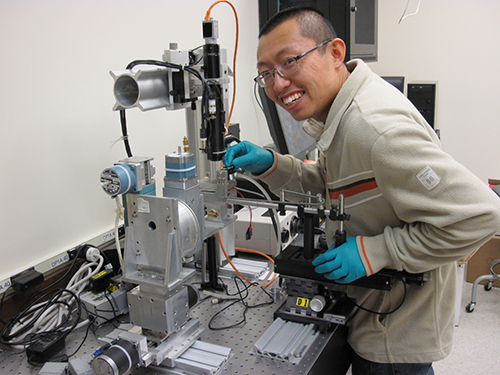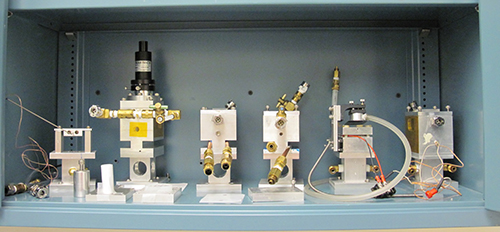X-RAY RUNS: Apply for Beamtime
2017 Nov 1 - Dec 21
2018 Feb 7 - Apr 3
2018 Proposal/BTR deadline: 12/1/17
2018 Apr 11 - Jun 4
2018 Proposal/BTR deadline: 2/1/18
In order to further the development of Real-Time In-situ Multiprobe (RIM) experiments for the Designer Solids and Organic Electronics Program at CHESS D1 station and others, the CHESS Sample Environment Lab has been established in room 171, the former User Computer Room. RIM experiments at CHESS have reached a degree of complexity that a permanent lab was set up, in which users can test and develop their experimental set-ups as well as can be trained in the use of CHESS sample cells and ancillary equipment. A mock-up of the D1 station sample goniomenter is set up on an optical table (Figure 1) and can be equipped with a sample microscope, an optical spectrometer, or an optical film thickness monitor, so that complex experiments can be prepared and tested, before the equipment is transferred to the beamline. In addition, new instrumentation can be developed in CHESS down times and while the D1 hutch is in use for the CESR-TA accelerator physics program.

Figure 1. CHESS postdoc Ruipeng Li setting up the D1 shear coating stage on the D1 beamline mock-up in the Sample Environment Lab.
At D1 station, samples can be characterized in-situ with GISAXS and GIWAXS as well as x-ray reflectivity, and grazing incidence fluorescence. D1 station provides a variety of sample environments for solvent vapor and thermal treatment of soft materials such as block copolymers, nanocrystal superlattices, and conjugated molecules and polymers. The lab provides a limited chemical vent and is cleared for performing test experiments with small amounts of standard solvents. A Q-Sense quartz crystal monitor with dissipation (QCM-D) system is availble for the ex-situ characterization of deposition from the liquid phase. A UV ozone cleaner is provided for sample cleaning right before experiments. Additionally, chemical preparation of samples can be performed in the flow hood in the CHESS Chem Room and the CHESS Glove Box Lab across the hallway.
Further instrumentation is in development in collaboration with user groups and as part of projects in the Masters of Engineering program at the Cornell School of Chemical and Biomolecular Engineering and the European MaMaSelf program which CHESS recently joined as a partner. Workbenches are available for the assembly and maintenance of sample cells and other instrumentation. Please contact the station scientist for further information.

Figure 2. D1 sample stages for solvent vapor and temperature treatment.
Submitted by: Detlef Smilgies, CHESS, Cornell University
03/28/2014
